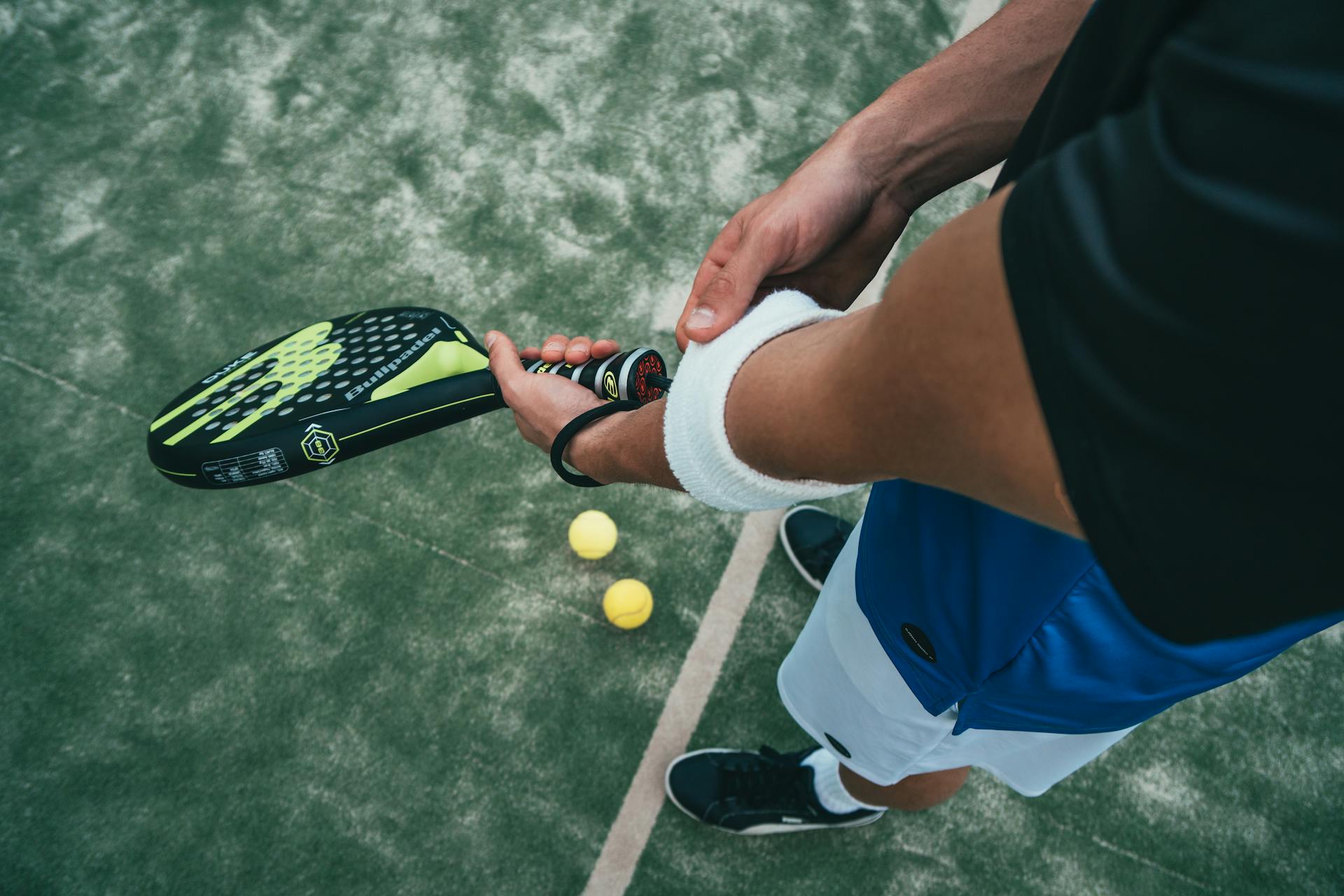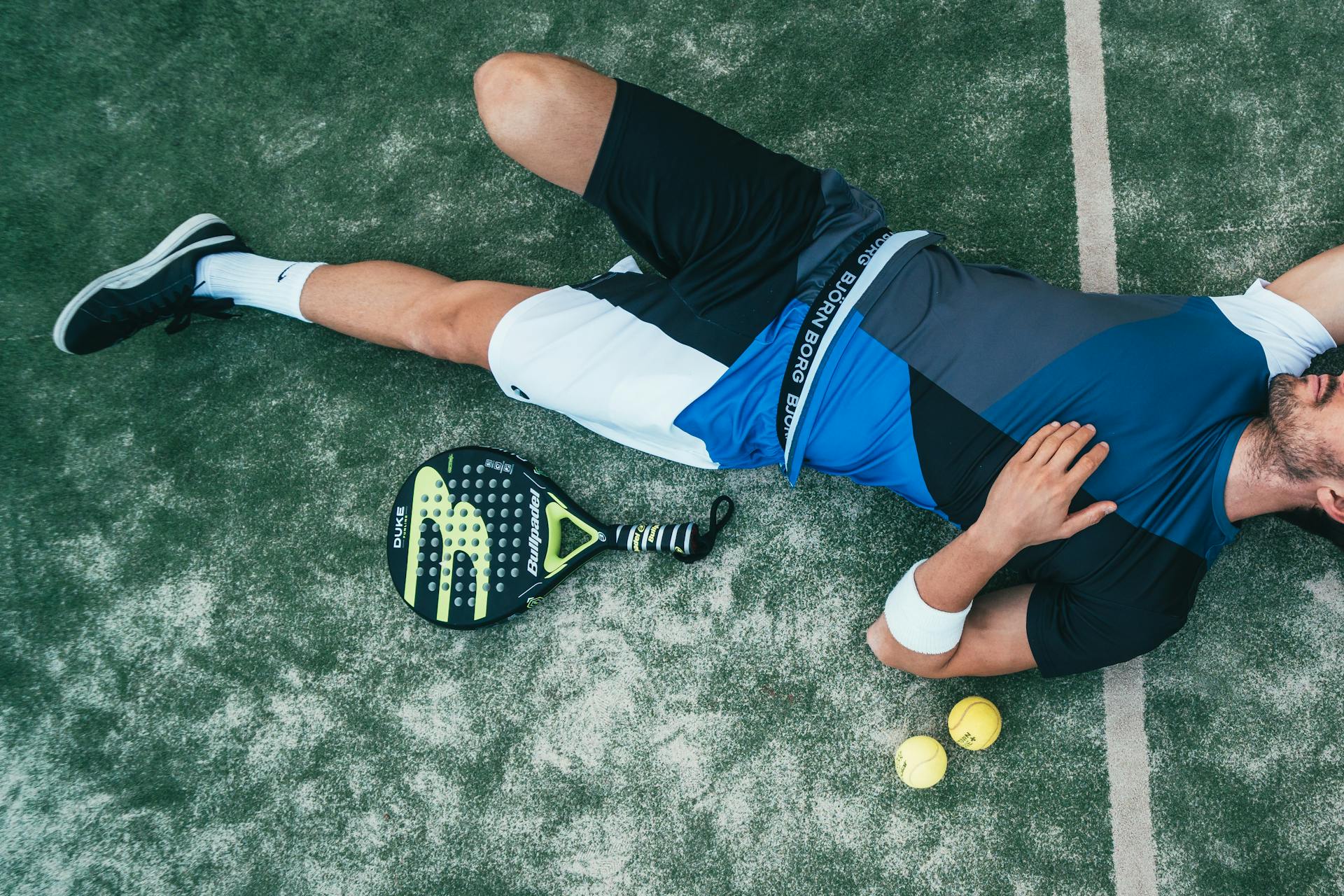
Taping is an effective non-invasive treatment option for managing tennis elbow. It can help reduce the pain associated with this condition by providing joint stability and compression at the site of inflammation.
The most popular approach to taping for tennis elbow is called Counter Force Brace or Half Moon Taping. This type of taping technique involves wrapping a piece of athletic tape around the area just below your elbow (typically within 3–4 cm proximal to your lateral epicondyle). The purpose is to create a counterforce against further muscle strain, thus reducing symptoms in this region.
To begin, start by cutting four pieces of two-inch wide athletic tape into half-moon shapes (ie semicircular). Then wrap them around either side of your lower arm and overlap it slightly with each piece in order to form an X-shape over the tendon attachment point just below the elbow joint. Make sure that there is no excess tension as you wrap each piece, since too much tension could lead to more pain or discomfort when you move your arm.
You can then attach the end strips across the back side of your forearm and adhere them firmly in place with additional pieces of tape or adhesive strips so they stay secure during any activity. Be sure not to wrap too tightly and check regularly that it’s not too constricting as you move throughout everyday activities, exercising, playing sports or anything else where you may be using your arm/elbow frequently.. You should also remove it before sleeping so that it can give time for inflammation itself heal without any external pressure placed on it while resting.. Lastly, make sure that if there are any signs or symptoms getting worse then stop taping immediately.echo medical attention from healthcare provider.
With regular use, wearing a counterforce brace/tape for tennis elbow gradually gets easier as well – so don’t worry if you feel awkward wearing one at first – because soon enough you will get comfortable with applying, removing, securing and positioning correctly etcetera.. In addition, doing stretching exercise will help reduce movement, increase blood flow and work towards full recovery..
Related reading: Increase Arm Strength
How do I treat Tennis Elbow?
Tennis elbow, or lateral epicondylitis, is a condition that causes pain and tenderness around the outside of the elbow joint. It often occurs as a result of overuse or repetitive motions that put excessive strain on the muscles and tendons in your forearm. While there are a variety of treatments available to help alleviate symptoms, it's important to determine the cause before you can decide what type of treatment will be best for you.
The first step in treating tennis elbow is to rest and avoid any further activity that increases tension on your forearms. Stretching exercises can also be beneficial in increasing flexibility which helps relieve tension on the affected areas. Non-steroidal anti-inflammatory medications such as ibuprofen may also provide some relief from pain and inflammation. Using an ice pack at least once per day may also aid with this recovery by reducing swelling and numbing any discomfort felt during movement of your arm or hand.
In addition to these more conservative treatments there are other options as well including physical therapy to strengthen weak areas through targeted exercises and even Ortho-Bionomy®, an effective form os soft tissue therapy proven to eliminate chronic pain with gentle maneuvers that re-educate neural pathways for altered motor control patterns resulting from repeated trauma due to overuse injuries like tennis elbow.
It’s important for anyone suffering from tennis elbow not only treat their condition with care but also adjust movement patterns in order to prevent future flare ups; this may involve changes in how they hold equipment as well as adjusting how they play specific strokes or activities involving prolonged use of elbow joint muscles so they don’t put too much pressure on them unnecessarily when playing sports like tennis, golf or other racquet sports where similar strokes occur – optimizing one’s choice–or grip size -on equipment plays a role here too.
Suggestion: Put Golf Clubs
What exercises help alleviate symptoms of Tennis Elbow?
Tennis elbow (medically known as lateral epicondylitis) is an injury to the tendons that attach your forearms muscles to the bones of your elbow. It is a common injury among athletes, especially among people who play racquet sports such as tennis. Fortunately, there are several exercises that can help alleviate symptoms of tennis elbow.
One exercise you can try is wrist flexion and extension stretches. To perform this exercise, start by sitting down and crossing one arm across your body with the palm facing up. Reach over with your other hand and grab onto the fingers of the affected arm, gently pulling down so that you feel a stretch in your forearm muscle on the thumb side. Hold this position for 10-30 seconds and then switch arms, repeating twice on each side. Doing this stretch three times per day effectively increases flexibility in the forearm muscles which help decrease pain associated with tennis elbow injuries.
Another useful exercise for relief from tennis elbow is wrist circles — also known as “pinch-and-release” exercises – which aid in strengthening forearms through improving muscular endurance and control over range of motion. Place both hands together in a neutral position where there isn’t any tension or pain felt in either arm When starting exercise make sure circular motion starts slowly while gradually increasing velocity throughout; tracing full circle while keeping thumbs parallel to one another during each repetition until completing 2 sets of 10 repetitions per day
Finally, performing eccentric loading exercises can benefit those suffering from tennis elbow by helping strengthen against further irritation due using resistance band to apply force opposite direction when extending & contracting elbows into its full range of motion; As sports doctors & physiotherapists recommend doing 3 sets of 15-30 repetitions depending severity level at least three times per week you increase team strength & more importantly reduce stiffness/pain.' For these types eccentric loading exercises it should be noted not increase speed like when performing concentric exercises but instead slow downwards movements create even low level resistance that helps condition arms better than simply stretching them out has proven effective many afflicted with EL
By completing these stretches and strength-building exercises aimed specifically at those suffering from Tennis Elbow regularly for some time now been able see substantial progress towards effectively managing intense discomfort usually diagnosed associated condition giving me believe same solutions may prove beneficial others seeking relief too.
Broaden your view: Increase Stamina
Are there any medications that may help with Tennis Elbow?
Tennis elbow, also known as lateral epicondylitis, is a painful condition caused by overuse or injury of the muscles and tendons that control movement in the elbow. It can be a debilitating condition for active people or athletes. Fortunately, there are medications available to help relieve the pain and inflammation associated with tennis elbow.
Nonsteroidal anti-inflammatory drugs (NSAIDs) like aspirin and ibuprofen can ease the pain caused by tennis elbow by reducing inflammation in the tissues around your elbow joint. Applying ice to your affected arm may also help reduce swelling and pain. Depending on how severe your symptoms are, you may benefit from corticosteroid injections into your affected arm to quickly reduce any swelling or discomfort.
Physical therapy is also an effective way to treat tennis elbow since strengthening exercises can help build up muscles around your injured area while stretching them out helps improve flexibility in those areas. Your physical therapist may suggest foam rolling or stretches that target specific muscle groups that affect movement in your arms so they’re better able to support those movements without resulting in further injury or strain on yourself.
In some cases, surgery may be necessary if other treatments are not successful at relieving symptoms of tennis elbow; however this is usually not recommended until all other treatment options have been explored first as it does come with risks like infection and complications due to anesthesia use during surgery itself.. Although these potential risks are small when compared with faster recovery time after surgery versus non-surgical options; it's always important discuss all options with a doctor before deciding which route is best for you!
Here's an interesting read: How to Train a Husky to Not Run Away?
What are the long-term effects of Tennis Elbow?
Tennis elbow, or lateral epicondylitis, is a fairly common ailment that can be caused by overuse of the forearm muscles. It can occur in sports such as tennis, golf and squash and even in those who work with their arms such as carpenters or painters. Though it’s often seen as a minor injury, if ignored it can cause a variety of long-term effects that may never fully heal unless properly treated.
The most common symptoms associated with tennis elbow are localised pain in the outside of the forearm along with tenderness when pressure is applied. Over time this pain tends to extend to include movements involving wrist flexion or extension and gripping activities. This can lead to difficulty performing activities needed for daily living like opening doors or shaking hands.
In cases where rest and treatment with anti-inflammatory medication fail to improve symptoms, there are several potential long term effects that may occur from chronic strain on tendons involved in wrist motion:.
1) Tendon degeneration - If inflammation goes untreated it could lead to decreased range of motion due to disruption from adhesions that form between tissues during healing. This causes deterioration as well as thickening through scar tissue formation which causes further difficulty when using the affected arm for movement control;
2) Nerve damage - Prolonged swelling and decreased blood flow may result in direct nerve damage resulting in tingling sensations up into the arm;.
3) Chronic Pain - Tendons thinning along with chronic inflammation spells trouble when attempting repetitive activity due to weakened muscles leaving you tired after limited use;.
4) Atrophy - It’s possible for muscles used to move your wrist joints around become weak leading them being unable shorten even further heightening already lowered strength levels;.
In order reduce risk of suffering any serious long-term damage from tennis elbow injury it’s important take at least 10 days rest before retrying any strenuous exercises whilst also treating affected area ice packs three times daily supported by anti-inflammatory medication where necessary.
Suggestion: What to Wear When Running in Rain?
How can I prevent Tennis Elbow from recurring?
Preventing tennis elbow from recurring is an important goal for any athlete or recreational sports person. To achieve this, it’s essential to address the root causes of the injury and develop strategies to minimize the likelihood of its recurrence.
One measure which can be taken to prevent tennis elbow from returning is ensuring that warm-up and stretching exercises are integrated into every workout routine. Before beginning any form of physical activity, taking time to complete light stretching and warm-up movements will reduce the risk of straining muscles throughout intense periods of play or practice. Additionally, overworking certain areas can also contribute to a recurrence in injuries such as tennis elbow; keeping within your skill level when playing may help prevent these related issues.
Another great way to assist in preventing injury occurs during play itself; avoiding an overly rigid grip on racquets or other equipment being used can reduce stress on joints and muscles which could compromise performance over time and lead to further complications down the line such as clubbed fingers or chronic pain syndromes. Equipping yourself with high quality sport gloves made with breathable materials may also support blood circulation in impacted areas during longer perseverances on court plus providing additional cushioning against any potential impacts from your opponents racket swings or volleys.
Finally, addressing diet habits can be particularly beneficial when aiming at prevention of tennis elbow from occurring again – hydrating adequately before games along with eating a balanced meal are both integral components when consistently performing at peak levels especially under adverse conditions like extreme heat or humidity levels which require additional energy needs for replenishment purposes during long timers out there on court! Furthermore supplement consumption such as Vitamin D3 may support people prone towards recurring injuries like tendinitis given its recognised anti-inflammatory properties based upon scientific studies so far completed on this subject matter by medical professionals around The World who have researching its application in preventing musculoskeletal disorders affecting athletes everywhere today!
If this caught your attention, see: Tennis Court
How can I improve my form to avoid Tennis Elbow?
Tennis elbow, or lateral epicondylitis, is a common injury that can take away your enjoyment of the game. To avoid it and improve your form, you should focus on strengthening the muscles in your forearm. You can do this with exercises like wrist extensions and curls. Additionally, it’s important to use proper technique when playing; making sure to keep you don't grip too tightly or keep an unnatural bend in your arm for too long.
Always warm up before playing by stretching the arm out and completing some dynamic stretches such as moving wrist rotations. This will help prevent any micro-tears that could lead to serious issues later down the line; not just tennis elbow but rotator cuff tears as well! It’s also important to use a racquet that properly fits both your size and skill level; if needed adjust string tension levels accordingly. This will make sure that no matter what type of stroke used (forehand/backhand) you won’t be over straining yourself unnecessarily while still getting maximum power in each swing! Additionally make sure there are no bad habits when it comes to serving position; start with both feet directly facing forwards rather than at an awkward angle – this should reduce stress on the elbow joint dramatically!
In general: focus on warming up correctly before practice or play, use correct form when playing (good mechanics), pay attention to any areas where tightness persists within muscles groups/joints and make sure a racquet size is suitable for individual height & power output needs! If done correctly these simple tips should help avoid tennis elbow injury – allowing a person effortless pain free hits day after day :).
Intriguing read: Size Generator
Sources
- https://www.muellersportsmed.com/b2c-us/en/
- https://www.kttape.com/blogs/how-to-apply/tennis-elbow
- https://www.kttape.com/blogs/how-to-apply/general-elbow
- https://www.gov.uk/government/publications/covid-19-decontamination-in-non-healthcare-settings/covid-19-decontamination-in-non-healthcare-settings
- https://www.kttape.com/
- https://sports.yahoo.com/mlb/news/
- https://www.smh.com.au/lifestyle
- https://www.physio-pedia.com/Tennis_Elbow_Management
- https://tribunecontentagency.com/
- https://www.bupa.co.uk/health-information
- https://www.foxsports.com/mlb
- https://www.sandiegouniontribune.com/
- https://www.tennisexpress.com/
- https://www.aol.com/video/
- https://sports.yahoo.com/nba/news/
Featured Images: pexels.com


